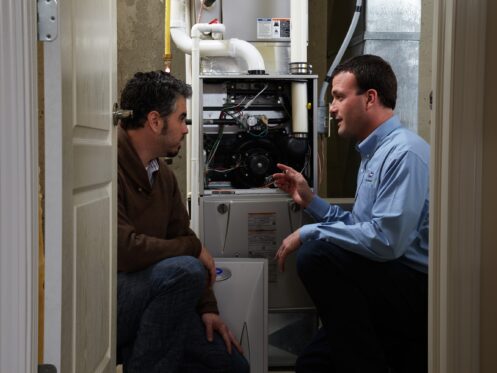Altitude changes the way air moves, burns, and retains heat, which means your HVAC setup needs to work a little harder. Alphalete Plumbing Drain Heating & Air in Colorado Springs, CO, understands the quirks that come with mountain living and can help you make the right adjustments for year-round comfort.
Furnaces Can Struggle to Ignite in Thinner Air
At higher elevations, your furnace might not burn fuel as efficiently as it would at sea level. At those altitudes. the air holds less oxygen, which throws off the combustion process. If your furnace was built and calibrated for lower altitudes, it may have trouble getting a clean burn. You might hear it click on and off without staying lit or notice it takes longer to heat your home than usual. That’s often a sign that your system needs to be adjusted for elevation.
Gas burners rely on the right mix of fuel and air to ignite and stay running. When oxygen levels drop, that mix changes. Your furnace may burn richer, which can produce soot, waste gas, or trigger safety shut-offs. Sometimes, the flame might be weak or yellow instead of strong and blue. That’s not just inefficient, it can also stress your system and shorten the lifespan of key components like the heat exchanger.
Some high-efficiency furnaces can be adjusted for altitude with a few setting changes, but older models might not be built for that kind of tuning. If yours can’t compensate, you might need different orifices on the burners or a new model rated for your elevation. It’s one of those problems that sounds dramatic, but with the right furnace repair or upgrade, your home can heat just as well as it would down closer to sea level.
Air Conditioners Lose Some of Their Power
When summer arrives, high-altitude homes don’t always get a break from the heat, as the sun can warm your space faster than you’d think. If your air conditioner isn’t keeping up, the problem could be the elevation.
Air at higher altitudes is thinner and carries less heat. That sounds helpful, but it makes it harder for your air conditioner to release heat into the outdoor air. Since the refrigerant inside your AC system pulls heat from your home and dumps it outside, that exchange gets less efficient in thin air. The outdoor unit works harder to push the heat out, and the system ends up running longer.
Your AC cycles more often or takes longer to cool things down. On especially warm days, it might feel like it’s blowing lukewarm air even though the system’s working nonstop. Some people assume their AC is undersized, but what’s really happening is the unit can’t dump heat as quickly as it would at lower elevations.
To fix this, you might need an AC replacement to get a system with a higher capacity or one designed to handle thinner air more effectively. You can also help things along by shading the outdoor condenser, keeping it clear of debris, and using indoor fans to improve circulation. But if your AC is older or wasn’t selected with altitude in mind, you’ll probably see better performance with a unit that’s built for these conditions.
Thermostats May Read Accurately But Still Miss the Mark
Sometimes, the thermostat looks like it’s working fine. It clicks on at the right time, shows the correct temperature, and keeps things within the set range. But you still feel warm in the summer or chilly in the winter. That mismatch between what the thermostat sees and what you feel is common in high-altitude homes.
Thinner air behaves differently, and that affects how heat and cold spread through your space. Warm air might rise faster and collect in odd spots. Cold air may drop more suddenly and settle where your thermostat can’t detect it. If your thermostat is in a hallway or a shaded part of the house, it might think the space is fine while the rest of the house feels off.
Humidity also plays a role, and in higher elevations, indoor air tends to stay dry. That can make warm air feel cooler than it really is, which tricks your body into thinking the heat isn’t working hard enough. You can try bumping the temperature up or down a few degrees, but that’s only a temporary fix.
Relocating your thermostat to a more central part of your home or switching to a smart model that learns your habits can help. Some systems let you use room sensors to balance temperatures better. These tweaks won’t change how air behaves, but they’ll help your system respond in a way that matches how your space actually feels.
Ventilation Gets Complicated in Thin Air
In low-oxygen environments, getting fresh air into your home becomes more important and more complicated. You still want to seal up your house to hold in heat or AC, but when air is already thin, poor ventilation can lead to stuffy rooms and stale air that lingers too long. Mechanical ventilation systems are one way to help, but they need to be selected and installed with altitude in mind. Heat recovery ventilators and energy recovery ventilators both pull fresh air in and push stale air out, but the airflow rates might need to be adjusted to work well at higher elevations. If they pull too much air too quickly, they can throw off your home’s pressure balance. You won’t get the fresh air you need if they move too slowly.
Bathrooms and kitchens are other problem spots. Exhaust fans work differently when the air is thinner. You might have fans that sound like they’re working fine but don’t move enough air to clear out moisture or cooking fumes. That leads to humidity buildup and odors that linger longer than they should. Opening windows helps, especially in the cooler parts of the day, but that’s not always a practical year-round solution. The best bet is to look at your ventilation setup as a whole. Make sure it moves air to fit your elevation, your home’s layout, and your comfort needs.
Ductwork Designed With Elevation in Mind
Air moves differently in thinner environments, including the air flowing through your ductwork. If your ducts were designed for a different altitude, you might have uneven temperatures, noisy airflow, or weak pressure in parts of your home.
Long duct runs or sharp turns can create resistance that becomes more noticeable when the air is thin. That resistance slows airflow, which means some rooms heat or cool more slowly than others. For example, a living room might stay comfortable while the bedroom upstairs always feels a few degrees off.
Leaks are another issue. When your duct system loses pressure, conditioned air leaks out before it reaches its target. That loss matters more when your HVAC system is already working harder due to altitude. Even small leaks can drop efficiency and throw off room-to-room balance.
Proper sealing, better insulation around the ducts, and thoughtful design updates can make a big difference. You may need dampers or zone controls to direct airflow more precisely. If you’ve already upgraded your HVAC equipment but still have trouble getting even comfort throughout the house, your ducts might be the problem.
Update Your HVAC System for Your High-Altitude Lifestyle
Our HVAC services team at Alphalete Plumbing Drain Heating & Air provides for all your heating, cooling and indoor air quality needs. Schedule a visit from us today, and get things running right for your altitude.


